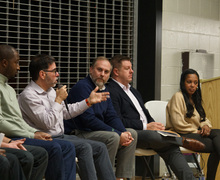‘Nickel Boys’ pushes cinematic boundaries of portraying a person’s life
Courtesy of the New York Film Festival
In “Nickel Boys,” first-person point of view shifts between the two main characters, Elwood and Turner. This technique powerfully shares their stories.
Get the latest Syracuse news delivered right to your inbox.
Subscribe to our newsletter here.
How can we portray life on a movie screen? Writer and director RaMell Ross, known for his 2018 documentary “Hale County This Morning, This Evening,” wants to push cinematic boundaries to answer this question.
Ross’ feature debut, “Nickel Boys,” is based on the 2019 Colson Whitehead novel of the same name. It employs a lesser-used form of cinematic perspective and nonlinear storytelling to create a cinematic world that is both sensory and naturalistic. Shot entirely from a first-person point of view, the film forges a new path for how life is depicted beyond a movie theater and in art as a whole.
To be clear, “Nickel Boys” isn’t the first movie to be shot entirely in the first-person. French director Gaspar Noé did this in his 2009 film “Enter the Void” to depict death and an out-of-body experience.
But for the material, Ross’ choice of perspective feels absolutely right.
The movie follows Black teenager Elwood Curtis (Ethan Herisse) in 1962 Jim Crow era Tallahassee, Florida, where he is sent to a segregated reform school and bonds with a boy named Turner. The school is a fictionalized version of the real-life Arthur G. Dozier School for Boys, which closed in 2011 with a history of constant racial abuse and beatings. These experiences of shared trauma and true friendships come right from the eyes of the two young men.
From the opening shot, we watch Elwood’s every move as he looks at an orange hanging from a tree. It is only after Hattie (Aunjanue Ellis-Taylor), Elwood’s grandmother and guardian, calls for him that the camera begins to move along with him. It has morphed into a vessel for Elwood and the idea of his life.
Initially, this technique feels a tad gimmicky, with characters conveniently approaching Elwood to relay the fact to the audience that this movie is in first person. But Ross tears down this assumption in short order. Our view of event sequences is obscured because that’s Elwood’s perspective, whether through tortuous means at the reform school or through it simply being nighttime.
But in a stroke of cinematic ingenuity, Ross again flips the film’s story and composition on its head. Shortly after Turner introduces himself to Elwood, the movie rotates between his and Elwood’s points of view. We finally get a complete view of Elwood, the person we have been following along with for the movie’s first and second acts.

Cole Ross | Digital Design Director
Through this change in who we see, Ross shatters any notion that there is any way to objectively view a person and their life. Once Elwood appears on screen for the first time, he becomes flesh and blood. Viewers actually have a chance to see Elwood as a complicated human rather than only see life from his perspective.
It’s then up to the audience to form their own version of Elwood Curtis, just as it is up to Elwood and Turner to figure that out themselves. By embracing subjectivity, Ross finds the ability to portray the painful and powerful realities these young Black men face together.
Ross continues to break down our preconceived ideas of how we portray the experiences of the disenfranchised of America. As the film progresses, it cuts decades forward to a middle-aged Elwood (Daveed Diggs) who is now researching the deaths and abuses that took place at the reform school.
This is where we find some of the more painful moments in the film. When it comes to depicting racial injustices in the United States, films like “12 Years a Slave,” “Selma” or “Detroit” want to painstakingly show how brutally Black people are subject to abuse by white authority figures.
Ross posits that these traumatic experiences do not stay at a fixed point in time, even in a film. Rather, the wounds perpetuate long after they happen and they remain intertwined with the soul for decades, as shown by the story jumping back and forth from the 1960s, 1980s and early 2000s. The emotional pain lives long after the physical, especially when it is met with deafening silence in a country that still needs to pay reparations for slavery.
The movie interweaves the history and pain of Elwood’s experience with an acknowledgment that subjectivity can more powerfully relay the emotions of human life. Feelings can contrast with one another for both Elwood and Turner, but we can still understand the humanity of it all.
Ross uses perspective to not only empathetically understand life and question how we portray it, but also to get the ball rolling further by asking whether films themselves can actually live, breathe and feel.
“Nickel Boys” will continue to screen as part of the 2024 New York Film Festival. Amazon MGM Studios will release it in theaters on Oct. 25 before streaming on Prime Video.
Published on October 1, 2024 at 9:43 pm
Contact Henry: henrywobrien1123@gmail.com






